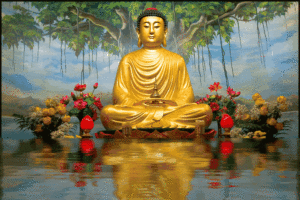Buddhism and Hinduism are not only the main religions of the Hindu population, but both have their origins in India. Today, both religions have spread throughout the world, although they agree in their preaching, meditation, prayer for peace, love and evolution of the mind; there are many differences in practice and theory.
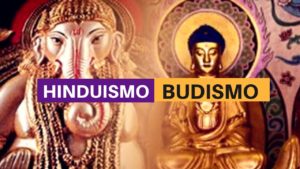
Buddhism.
Buddhism is a non-theistic mystical religion belonging to the Dharmic school of thought, whose religious philosophy has its origins in the teachings of Buddha (6th century B.C.), and is characterised by a belief in reincarnation and the pursuit of Nirvana through a life of silence, contemplation, austerity and moral discipline (see article: Origins of Buddhism).
Characteristics.
- Self-control. More than a religion, it is a philosophy.
- Salvation is the result of personal effort.
- It is possible to pass on tricks and merits to a dead person in order to achieve a better reincarnation.
- Meditation is done alone.
- Salvation is achieved by personal effort.
- The aim is to achieve a life without suffering by following the four truths: the knowledge of suffering, the origin of suffering, the suppression of suffering and the elimination of suffering.
- With these four truths, Buddhism seeks to attain enlightenment and, by accepting them, to find the path of the eight stages of Buddhism:

- Correct knowledge of the 4 Truths:
- Righteous attitude to keep away from desires, hatred and malice.
- Righteous speech: prudent and sincere speech.
- Righteous action: includes the moral life.
- Righteous occupation: to earn a living without disturbing others.
- Righteous endeavour: to restrain evil impulses and encourage good ones.
- Righteous Thinking: the pursuit of truth without passion.
- Righteous contemplation: through meditation.
- Right speech: wise and sincere speech.
Elements of Buddhism.
- Basic dogma is Dharma: acceptance in a cosmic order.
- Nirvana: dissolution of the self into nothingness after many reincarnations.
- The four noble truths
- One God Buddha
Doctrines.
God: There is no concept of a supreme God.
The Universe: Periodic creations are governed by an eternal law and have never had a beginning and will never have an end.
Ethics.
- I accept the precept of respect for life.
- Do not take what is not given.
- I accept the commandment of right sexual behaviour (that is not harmful to others or to oneself).
- Does not speak in a harmful way.
The three jewels of Buddhism.
Buddhas: Bodhi nature, Nirvana or Awakening.
Dharma: Buddhism, the teachings of the Buddha.
Sangha: the community of Buddhists.
https://www.youtube.com/watch?v=W68mgqiHqZo
Hinduism.
Definition: A religious tradition of India practised since time immemorial. It encompasses a wide range of beliefs that have evolved over the centuries into diverse forms of worship, philosophy and spirituality. The origin of the word Hindu comes from the ancient Persians, who called the people who lived beyond the Indus River. The name given to India is known to only a few: “Varsha Bharata” and the real name of their religion is: “Sanatana Dharma”. (see article: Shingon Buddhism)
Characteristics.
- It is rather a set of religious, philosophical and cultural ideas and practices that originated in India.
- It has no founder and no date of birth.
- Belief in reincarnation.
- The concept of divinity or “absolute being” through its many manifestations.
- The law of cause and effect and the desire to break free from the cycle of rebirth.
- The language of its sacred books is “Sanskrit”, it has no word for “religion”, it is replaced by the word “Sanatana Dhama (Perfect Order).
Elements of Hinduism.
- Caste systems
- Karma and reincarnation
- Brahman: the only thing that really exists (the ONE – ALL)
- Krisna: Supreme God
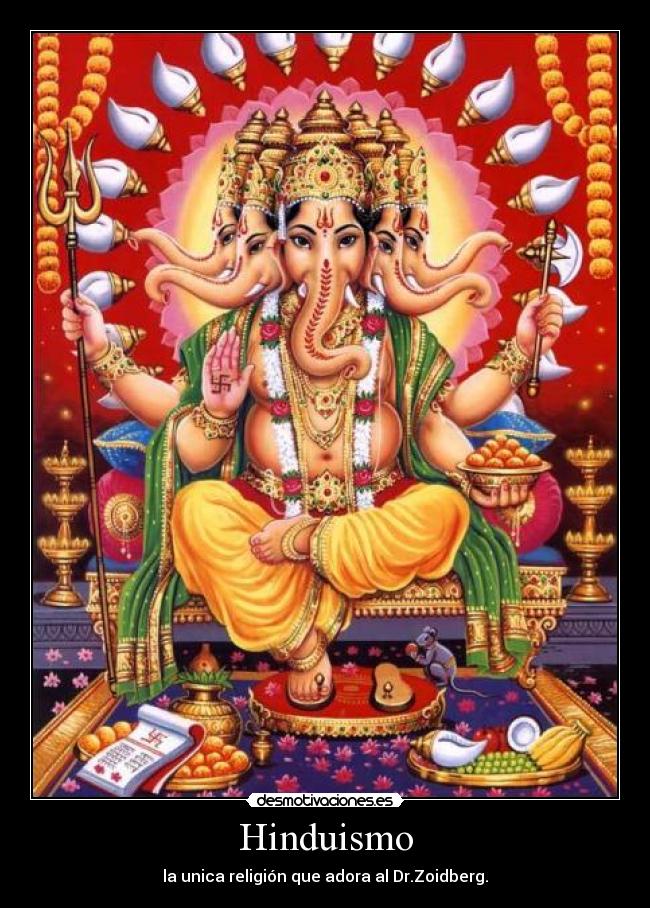
Doctrines.
A variety of beliefs can be found, but in one basic aspect the Hindu has his belief behind the visible universe to which he assigns successive cycles of creation and destruction, there is another existence but no change. Abandoning the cycle of reincarnation and returning to the spiritual universe is the greatest achievement of all.
They believe in a Supreme, but their complexity is such that we can hardly describe them, since one of their main characteristics, as we have already pointed out, is their multiplicity of gods.
As to the nature of this Supreme Being in their main belief:
- God is an impersonal energy: their god is called Brhaman, all other beings are his expression.
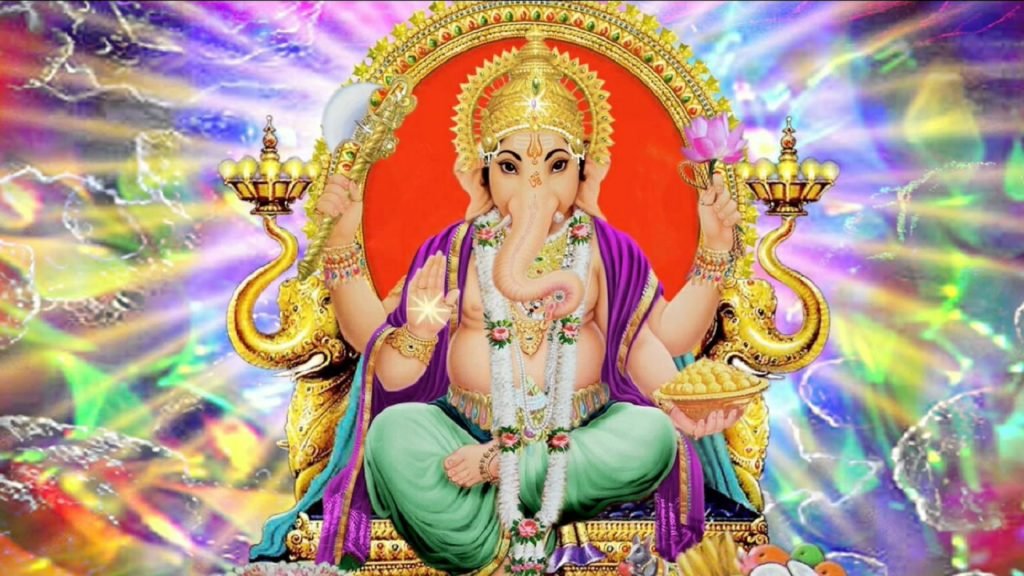
Buddhism and Hinduism: Differences and similarities.
In some cultures, especially in the West, there is a tendency to think that both religions are the same and mean the same thing; however, although both have their origins and beginnings in India, each has completely different theories and practices. What may make them similar is that they have similarities, and it may be that this has led to the belief that they are the same. Later, as we develop the topic, we will learn what makes them different.
Differences:
- Buddhism is a non-theistic religion (it worships a single god, Buddha), whereas Hinduism is theistic (it believes in several gods: Vishnu, Shiva, Brhama).
- Buddhism rejects the idea of Atman, which in Hinduism is the consciousness or spirit soul.
- The ultimate goal of Buddhism is to attain enlightenment (nirvana), whereas the goal of Hinduism is to escape from samsara.
- Hinduism has a strong belief in a social system that perpetuates hierarchies, castes that must be respected regardless of the passing of generations. Buddhism, on the other hand, is the complete opposite in terms of caste and class distinctions.
Similarities:
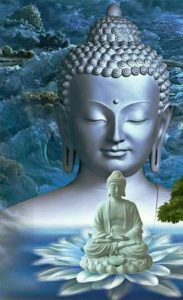
- They originated in India.
- They believe in a connection between life and death. Law of Taleon (punishment).
- They have managed to transcend over the years to have followers from all over the world, regardless of their origin and geography.
- It is based on the performance of right actions in order to create right consequences that affect life in a positive way.
- Both religions believe in the reincarnation of souls and transmigration. This means that they believe in life after death, that people are born, live and die to be reborn in a new life form.
- Vegetarianism is a practice of both religions.
- They both believe strongly in Kharma (although in slightly different ways).
- Neither Indian religion has a holy book like the Bible.
Meaning of the Hindu Buddha.
The meanings given to Buddha images can have different interpretations depending on the postures in which the hands are placed (see article: Nirvana Buddhism).
What does the image of the Buddha mean?
In Buddhism, each image of the Buddha represents protection, harmony, teaching, invocation and meditation. It is simply more than representing the one who was the creator of Buddhism in the most sublime form and represented in a statue, each representation of his different characteristics: poses, gestures of his hands, clothing. The aim is to symbolise each of his teachings, the most common of which are the hand gestures we know as mudras, as well as the poses typical of Buddhism or Hinduism.
However, there is a great variety of these figures. Here we will analyse the most representative ones of each religion, with their representation and meanings:
ABHAYA MUDRA:

It is depicted with the right hand raised to chest height with the palm facing forward, while the left hand points downward. This means protection, peace and absence of fear. A reassuring image that can inspire protection and peace.
DHAYANA MUDRA:
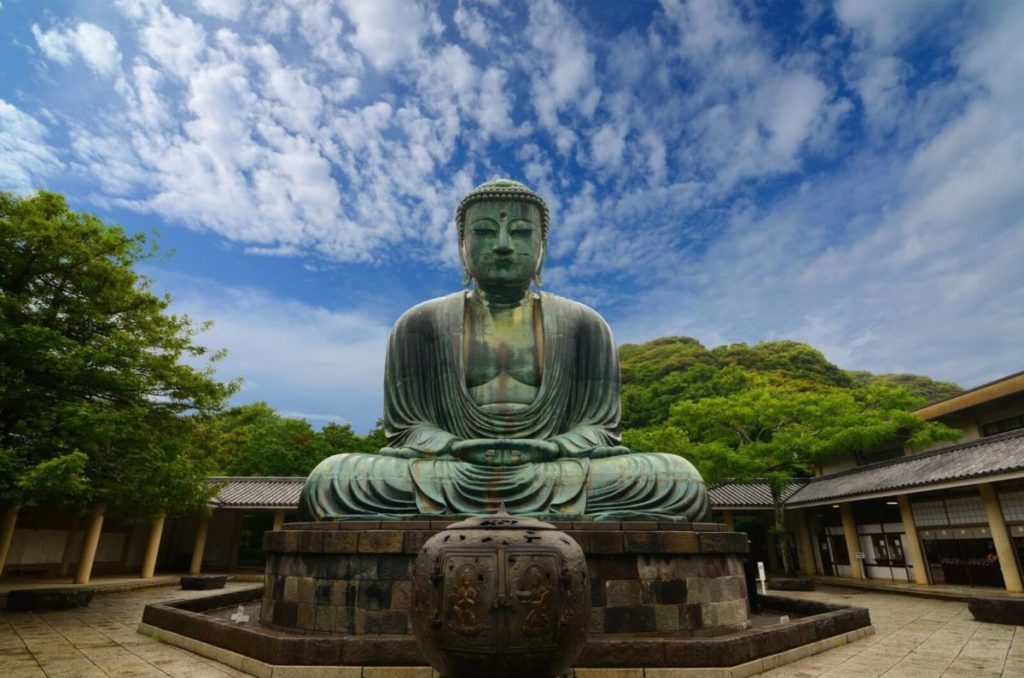
It is depicted with the back of the right hand resting on the left palm while the thumbs touch. This represents concentration, meditation and spiritual attainment. An image that can easily lead you to focus more on your goal of self-improvement.
DHARMACHAKRA MUDRA:
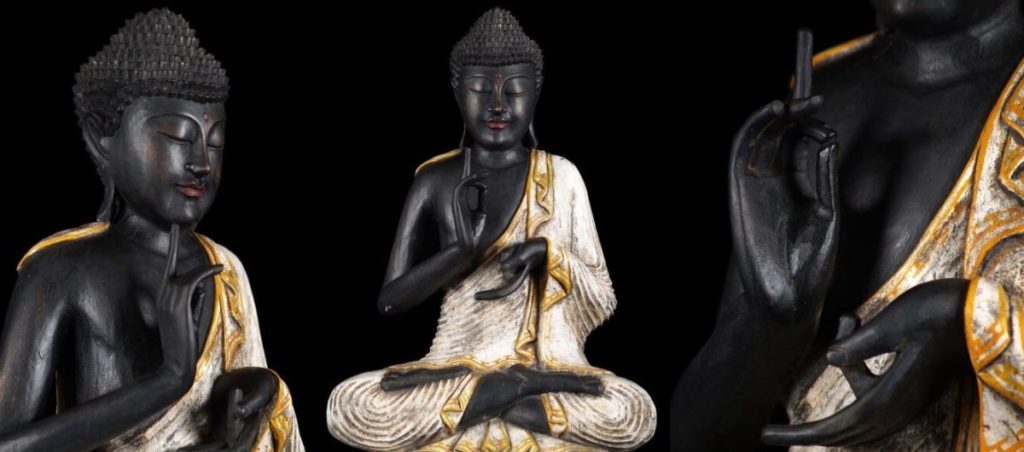
In this pose, the thumbs and forefingers of both hands are joined, but at chest height the right hand is slightly above the left. This represents universal perfection and the cycles of life. An image that can subtly reflect the perfection and roundness of the cycles.
VARADA MUDRA:
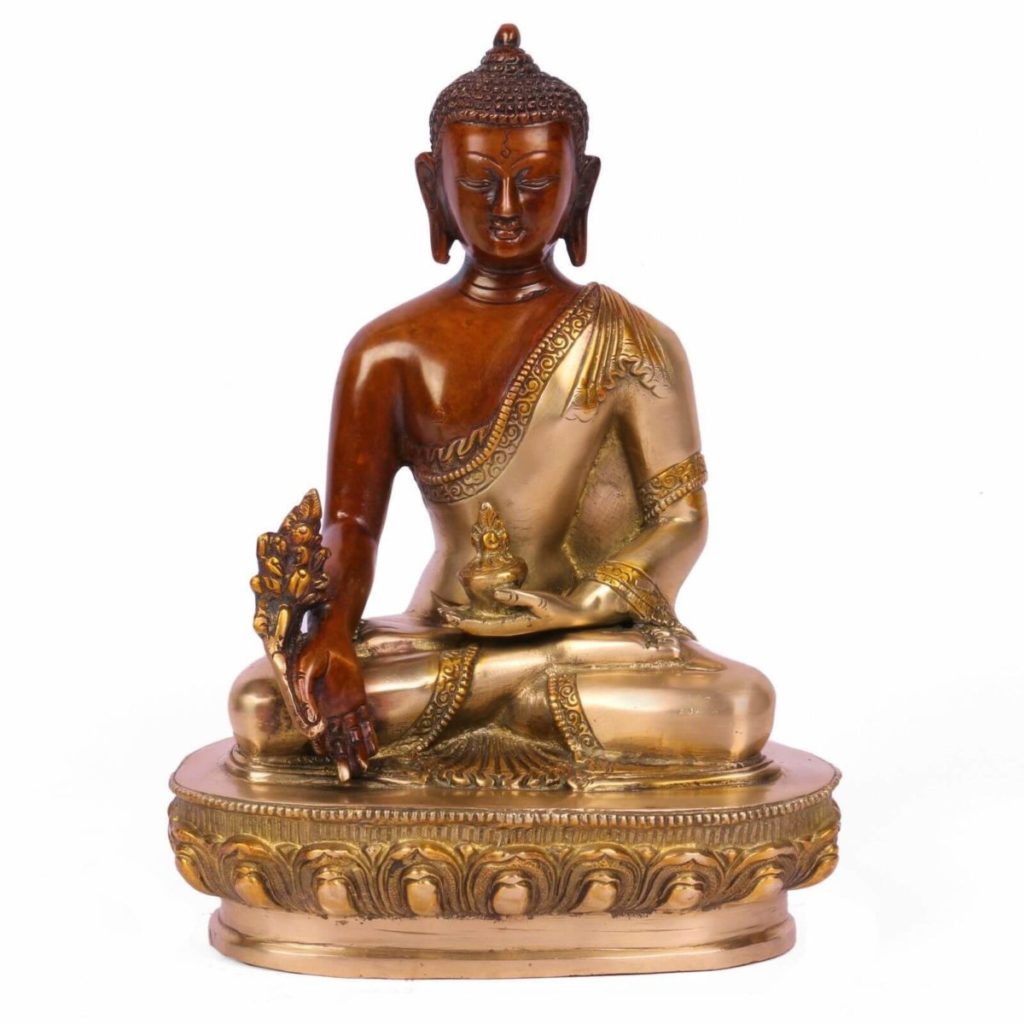
It is represented by the left hand pointing upwards and the right hand pointing downwards with the palm facing outwards. This signifies generosity, compassion and sincerity.
BHUMISPARSHA MUDRA:
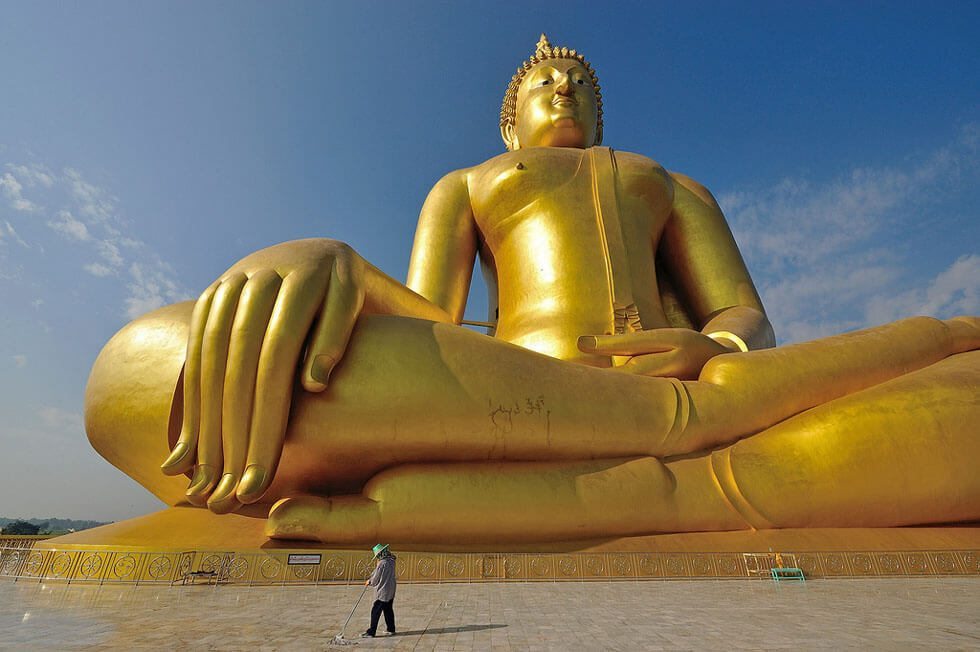
In its depiction, the left hand is resting, pointing upwards, while the right hand is pointing downwards, with the fingers just touching the ground. Its meaning: It symbolises the Buddha’s enlightenment under the tree.
Meaning of the Hindu.Thai Buddha.
In Hinduism there are thousands of gods, each with their own characteristics. Here are the main Buddhas or gods:
Brahma.
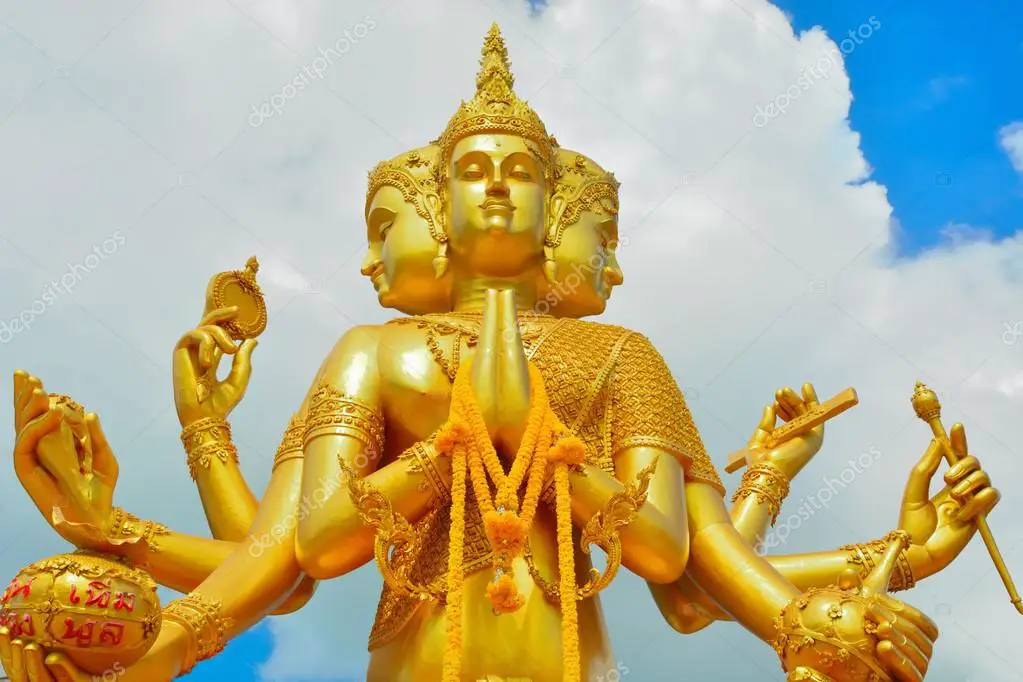
He is the Creator God who rebuilds the universe, the Lord of the creatures, the computer of the world. He is the first of the Trimurti, he represents the essence in which everything exists. He is a theological god, a product of intellectual speculation, who has practically no cult or popular sanctuary.
Today he is not worshipped independently, but is represented by four heads, symbolising that he sees in all directions. Creation, beginning and expansion are his premises.
Vishnu.
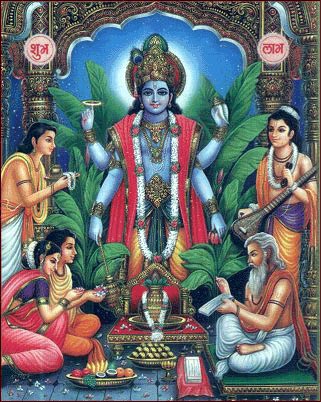
He is the second character of the Trimurti, difficult to define and understand. He is the product of the evolution of a very ancient Vedic God, the God who preserves and protects the universe, the God of space, omnipresent, immanent, everywhere, he meditates the world, preserves it, keeps it in balance, sustains all that exists.
He is depicted in blue with four arms, symbolising that he can reach the four corners of the world. Singnifica: preservation, life and protection.
Avatars of Vinsu:
Rama.
He is a Hindu hero, a personification on earth of the god Vishnu. Who came to free the earth from the demon Ravana.
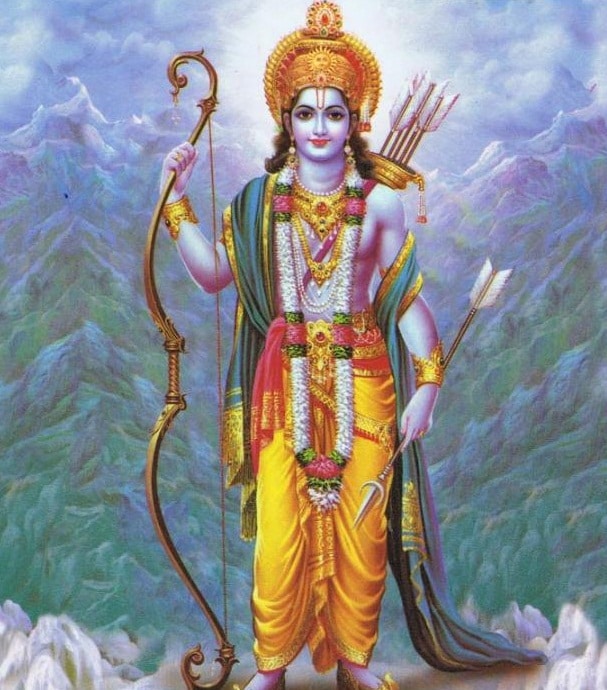
Krishna.
The embodiment of joy and love, he is famous for killing the demon king Kansa. He is usually depicted in blue and playing a flute.
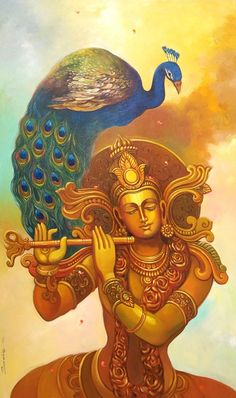
The founder of Buddhism Buddha, considered the ninth avatar of Vishnu, descended to earth to put an end to animal sacrifice.
Shiva.
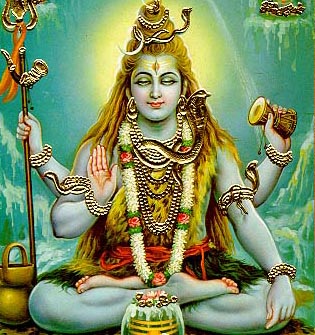
He embodies the cycles of birth, life and death. He is both creator and destroyer, protector and avenger.
He is depicted with four arms, matted hair, a moon on his head and a snake around his neck. His right hand holds a drum with which he accompanies the rhythm of his dance of liberation and creation. He also has a third eye, symbolising destruction, change and transition.
Ganesha.
He is the elephant-headed god, son of Shiva and Parvati. He is the god who removes obstacles and is therefore prayed to when a new task is to be undertaken. It is said that Shiva beheaded him in a fit of rage, but later brought him back to life by giving him an elephant’s head.
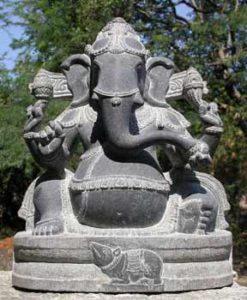
Buddhist practice. Karma.
- The law of karma is an example of the law of cause and effect, which states that physical, verbal and mental actions and experiences are their effects.
- It teaches why each individual has a unique mental disposition, physical appearance and experiences.
Hindu yoga practice.
- This term refers to a set of spiritual practices originating in India, the sole purpose of which is to achieve spiritual perfection.
- Hatha yoga is one of its branches and is currently the most widely practiced. Its aim is emphasised in the physical aspect, which is the path of transformation, its founder and promoter
- was Swami Swatamarama, in the 15th century.
- Yoga of Batki (devotion): Love is dedicated to one of the gods.
- Yoga of Karma (action): This path involves doing good deeds to counteract the negative karma that perpetuates the cycle of reincarnation.
- Yoga of Jana (knowledge): uses the power of the mind through meditation to reach the truth.
- Yoga of Raja: combines action, devotion and knowledge.
Foundations of Buddhism.
Hinduism is based on the following principles:
- Three characteristics of existence: impermanence, non-existence of self, unsatisfactoriness.
- Cause and effect (karma): according to Buddhism, every intentional or chosen action creates a variety of results and new conditions called maturations, which are of the same kind of moral quality as the action.
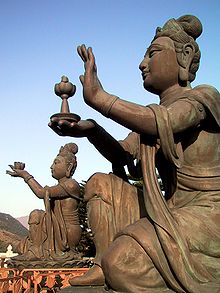
Origin.
It is an Indian religion from the 6th and 5th centuries BC. It began in northern India, its founder Sidharta Gauthana, who is now believed to have lived for 3000 years. Born the crown prince of a small kingdom, he enjoyed all the advantages of wealth and social status. But as a young man he became concerned with the problem of human suffering: ageing, sickness, death, renunciation, he realised that all people, rich or poor, experience certain inescapable sorrows.
He saw that people suffered in this world because they based their happiness on things like wealth, power, social status and love, which by their very nature are subject to change. He renounced his right to the throne for a religious life in search of an answer to this dilemma that was the human condition.
Foundations.
The basic teachings of Buddhism can be found in these two main points:
4 Noble Truths:
- First Noble Truth: There is pain and suffering in the world. Life involves dunkha (suffering, dissatisfaction and pain) and the Buddha realised that pain is omnipresent in all human nature and life.
- Second Noble Truth: It relates to the cause or origin of suffering. It is Trsna (craving, desire, literally thirst). He believed that the root of suffering is desire; it is the craving for wealth, happiness and other forms of selfish enjoyment that causes suffering.
- Third Noble Truth: The End of All Suffering. Suffering can be extinguished by extinguishing its cause.
- Fourth Noble Truth: The “noble path” is the method of extinguishing suffering. By following the eightfold path.
8 steps to follow the path. Eightfold Path:
- Right Knowledge: Knowledge of the Four Noble Truths.
- Righteous Attitude: To keep away from desire, hatred and wickedness. Do not harm any living being.
- Right Speech: Prudent and truthful speech, only the truth should be spoken.
- Right Action: To live morally.
- Right Occupation: To earn an honest living. To work in an honest way that does not harm others.
- Righteous Endeavour: To suppress bad impulses and encourage good ones. To seek good and moral qualities and to develop those already possessed. Seek to grow in maturity and perfection until universal love is attained.
- Right Weighing: Strive to know the truth, to be attentive and complete.
- Right Concentration: The practice of meditation. To attain the state of eternal peace and bliss called ‘Nirvana’.
This is the way to eliminate suffering; following it leads to tranquillity and peace.

Basics of Hinduism.
It is an Indian religious tradition, also practised by families who have migrated from India to the rest of the world (especially South and East Africa, Southeast and East Asia and Europe). It is made up of several religions which are as diverse as they are opposite in form, there is a variety of beliefs. It is hereditary, meaning that you cannot convert to Hinduism, you have to be born a Hindu. It is also known by the word Sanatana-Dharma, which means ‘eternal religion’.
Fundamentals.
One of its fundamental pillars is the belief in reincarnation, which is linked to the caste system (the name given to a person according to his or her social status). According to the doctrine, every person who dies is reincarnated as another person or animal, and this cycle repeats itself forever over the centuries. If a person reincarnates as someone from a lower caste or as a so-called untouchable, it is because his behaviour (karma) in his previous life was not good. Since it is not possible to remember past lives, Hindus resign themselves to their fate without even thinking of revealing themselves, believing that they are the only ones responsible for their precarious situation.
Many worship Shiva, Vishnu and Devi, as well as hundreds of lesser deities. They preach love for all living beings. One of the most difficult things to understand about this religion is the nature of their gods.
One of their goals is to get rid of samsara (the wheel of reincarnation) and reach nirvana, a goal that only a privileged few can achieve. They are the Sadus, Ascretes and Santons who dedicate their lives to achieving this goal. The tools used to achieve this goal are meditation, yoga, fasting and mortification of the body.
Many of these sadus renounce all possessions and live as hermits without contact with society.
All Hindus believe in a Supreme Being, but there are two main beliefs about the nature of this Being:
- God is an impersonal energy
- God is a person
In the impersonal Hindu stream, God is called Brahman. All others are merely His expression. Their idolatry may allow them to put their god in a statue for worship.
Basic principles:
- Non-violence
- Truthfulness
- Non-stealing
- Detachment from the results of actions
- Possession of what is necessary
Symbols.
Both Buddhism and Hinduism have different representative symbols for their respective beliefs and spiritualities, so let’s look at some of them.
In Buddhism we find the Dharma Wheel, which can be translated into English as the Wheel of Teaching or the Wheel of Law. This is one of the oldest Buddhist symbols we can find in Buddhist art and it represents religion.
The centre of the wheel symbolises discipline, a primordial and fundamental quality for effective meditation and spirituality, while the rim connecting the spokes represents consciousness, capable of sustaining the whole.
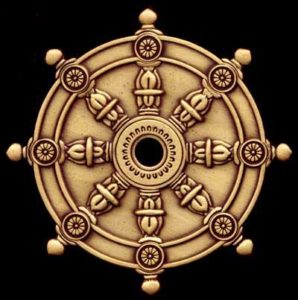
In Hinduism we find the sacred syllable, the origin and principle of all mantras.
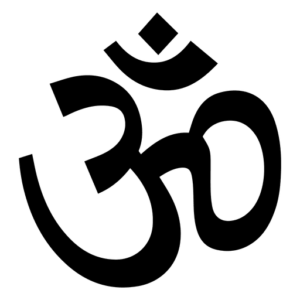
Sacred texts of Buddhism and Hinduism.
As with any religion, Buddhism and Hinduism have some sacred texts that guide and direct the beliefs and lifestyles of their followers, so let’s see what they are.
Hinduism accepts as sacred texts the Vedic literature, which contains a large number of ancient texts. Among these we can quote
SHRUTI (Vedas)
These are religious texts, the Vedas meaning knowledge. These texts contained necessary information for the performance of sacred rituals. These Vedas were handed down orally: families of priests transmitted the texts from generation to generation using complicated systems so that nothing was lost.
- Rigveda: Dating from the 6th to the 10th century BC, it is the stanzaic Veda composed of 1028 hymns collected and preserved by the priestly families. These songs in praise of the gods, these prayers accompanying sacrifices, these verses or invocations are still recited today at weddings and funerals.
- Yajurveda: this is the Veda of formulas, a kind of liturgical ritual. It contains both the formulas that are recited during sacrifices and the prose commentary on these formulas.
- Samaveda: a compilation of the main stanzas of the Riveda and Yajurveda, accompanied by musical notations to adapt them to chanting.
- Atharvaveda is an anthology of incantations and exorcisms closer to magic than to primitive religion. It shows the influence of a new caste, the Brahmans, far removed from the teachings of the Rigveda.
SHMRITI
Upanishad
Mahabharata
Ayur Veda
Within Buddhism we find the Pali Canon or Tripi Taka, a set of ancient manuscripts written in the Pali language, which form the basis of Buddhism and give shape and form to the religion.
Clothing.
In Buddhism, clothing has the following characteristics:
- They are dark, subdued colours such as black, grey or brown.
- They are made of cotton, silk or linen.
- They are rectangular in shape and their parts are joined to form bands resembling a rice field.
- They are used in Buddhist practices.
Within Hinduism, it is the women’s dress that is most striking, let us see:
- They wear a garment called a sari, made of very fine silk and cotton, with bright colours and beautiful embroidery.
- The tika or bindi is a small red dot on the forehead. It is worn as a symbol that the woman is married or engaged.
Point of view.
If you still have doubts about the differences between these two curious, ancient, but above all fascinating religions and cultures, I invite you to watch the following video, which will clarify your ideas a little more.

